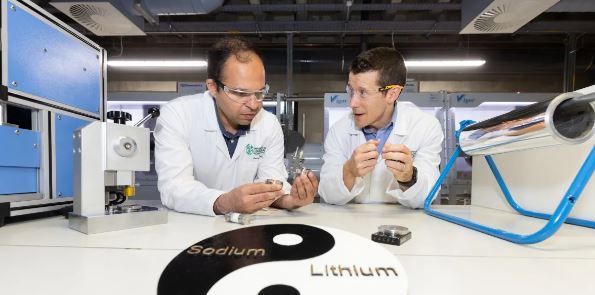Science
University of Limerick Unveils Groundbreaking Dual-Cation Battery

Researchers at the University of Limerick have made a significant breakthrough in energy storage technology by developing the world’s first full-cell dual-cation battery. This innovative battery system, which combines lithium and sodium ions, offers enhanced capacity and stability, potentially transforming the landscape of electric vehicles and portable electronics.
The research, published in the journal Nano Energy, was spearheaded by Hugh Geaney, Associate Professor in Chemistry at the Department of Chemical Sciences and Principal Investigator at the Bernal Institute, alongside Dr. Syed Abdul Ahad, a postdoctoral fellow. Their collaboration also included experts from the University of Birmingham.
Unlike conventional sodium-only batteries, this dual-cation system leverages the advantages of both lithium and sodium. The technology retains sodium as the primary component while utilizing lithium for performance enhancement, resulting in a more efficient and sustainable energy source. Geaney stated, “For the first time, we’ve shown that sodium-ion batteries can be ‘supercharged’ by pairing sodium and lithium in a sodium-dominant dual-cation electrolyte.”
Dr. Abdul Ahad, who conceptualized the study and conducted the experimental work under Geaney’s guidance, explained the breakthrough further. “By introducing both lithium and sodium cations, we actually double the battery’s capacity that would otherwise be lower in a typical sodium-ion battery. This has never been done before on the anode materials we used, which are projected to have high capacity for sodium-ion batteries.”
The design of the battery allows lithium to act as a “capacity booster” within the electrolyte. This not only improves energy density—crucial for extending the range of electric vehicles—but also enhances safety and sustainability by minimizing reliance on expensive and environmentally problematic materials like cobalt.
Historically, sodium-ion batteries have been viewed as a more sustainable alternative to lithium-ion batteries. However, they typically have lower energy density, leading to reduced performance. The new development indicates that sodium-ions can indeed deliver high capacity. The lithium and sodium ions work collaboratively during charging and discharging cycles, enabling the battery to function effectively for up to 1000 cycles, thereby offering a greener and more cost-effective solution.
Financial support for this research came from the Government of Ireland Postdoctoral Fellowship and the Research Ireland Frontiers for the Future programme. The research team is now looking to expand their work by exploring new material combinations and ion systems. This includes investigating silicon-based anodes and alternative ion pairings, such as lithium-magnesium and potassium-lithium.
This milestone is the latest achievement from the Geaney Research Group, which is committed to innovating new materials for energy storage applications. Their focus extends beyond traditional lithium-ion batteries, emphasizing materials characterization and design to maintain their position at the forefront of battery technology.
With over 30 active researchers involved in UL’s battery cluster and the multidisciplinary AMPEiRE centre for battery and energy materials research, the University of Limerick is poised to remain a leader in next-generation energy solutions.
-

 Top Stories3 months ago
Top Stories3 months agoTributes Surge for 9-Year-Old Leon Briody After Cancer Battle
-

 Entertainment4 months ago
Entertainment4 months agoAimee Osbourne Joins Family for Emotional Tribute to Ozzy
-

 Politics4 months ago
Politics4 months agoDanny Healy-Rae Considers Complaint After Altercation with Garda
-

 Top Stories4 months ago
Top Stories4 months agoIreland Enjoys Summer Heat as Hurricane Erin Approaches Atlantic
-

 World5 months ago
World5 months agoHawaii Commemorates 80 Years Since Hiroshima Bombing with Ceremony
-

 Top Stories3 months ago
Top Stories3 months agoNewcastle West Woman Patricia Foley Found Safe After Urgent Search
-

 Top Stories5 months ago
Top Stories5 months agoFianna Fáil TDs Urgently Consider Maire Geoghegan-Quinn for Presidency
-

 World5 months ago
World5 months agoCouple Convicted of Murdering Two-Year-Old Grandson in Wales
-

 World5 months ago
World5 months agoGaza Aid Distribution Tragedy: 20 Killed Amid Ongoing Violence
-

 World5 months ago
World5 months agoAristocrat Constance Marten and Partner Convicted of Infant Murder
-

 Top Stories4 months ago
Top Stories4 months agoClimbing Errigal: A Must-Do Summer Adventure in Donegal
-

 Top Stories4 months ago
Top Stories4 months agoHike Donegal’s Errigal Mountain NOW for Unforgettable Summer Views









